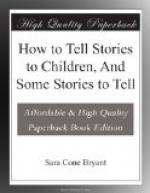And the Little Mill ground beautiful, white, powdery salt. When they had enough, the Captain said, “Now you may stop, Little Mill, and stop quickly.” The Little Mill kept on grinding; and the salt began to pile up in little heaps on the deck. “I said, ‘Stop,’” said the Captain. But the Little Mill ground, and ground, faster than ever, and the salt was soon thick on the deck like snow. The Captain called the Little Mill names and told it to stop, in every language he knew, but the Little Mill went on grinding. The salt covered all the decks and poured down into the hold, and at last the ship began to settle in the water; salt is very heavy. But just before the ship sank to the water-line, the Captain had a bright thought: he threw the Little Mill overboard!
It fell right down to the bottom of the sea. And it has been grinding salt ever since.
BILLY BEG AND HIS BULL[1]
[Footnote 1: Adapted from In Chimney Corners, by Seumas McManus. I have ventured to give this in the somewhat Hibernian phraseology suggested by the original, because I have found that the humour of the manner of it appeals quite as readily to the boys and girls of my acquaintance as to maturer friends, and they distinguish as quickly between the savour of it and any unintentional crudeness of diction.]
Once upon a time, there was a king and a queen, and they had one son, whose name was Billy. And Billy had a bull he was very fond of, and the bull was just as fond of him. And when the queen came to die, she put it as her last request to the king, that come what might, come what may, he’d not part Billy and the bull. And the king promised that, come what might, come what may, he would not. Then the good queen died, and was buried.
After a time, the king married again, and the new queen could not abide Billy; no more could she stand the bull, seeing him and Billy so thick. So she asked the king to have the bull killed. But the king said he had promised, come what might, come what may, he’d not part Billy Beg and his bull, so he could not.
Then the queen sent for the Hen-Wife, and asked what she should do. “What will you give me,” said the Hen-Wife, “and I’ll very soon part them?”
“Anything at all,” said the queen.
“Then do you take to your bed, very sick with a complaint,” said the Hen-Wife, “and I’ll do the rest.”
So the queen took to her bed, very sick with a complaint, and the king came to see what could be done for her. “I shall never be better of this,” she said, “till I have the medicine the Hen-Wife ordered.”
“What is that?” said the king.
“A mouthful of the blood of Billy Beg’s bull.”
“I can’t give you that,” said the king, and went away, sorrowful.
Then the queen got sicker and sicker, and each time the king asked what would cure her she said, “A mouthful of the blood of Billy Beg’s bull.” And at last it looked as if she were going to die. So the king finally set a day for the bull to be killed. At that the queen was so happy that she laid plans to get up and see the grand sight. All the people were to be at the killing, and it was to be a great affair.




